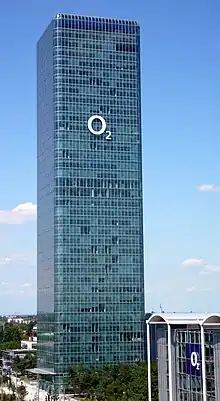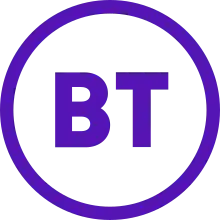.svg.png.webp) | |
 O2's German headquarters in Munich | |
| Type | GmbH & Co. OHG |
|---|---|
| FWB: O2D MDAX Component | |
| Industry | Telecommunication |
| Founded | 29 November 1995 |
| Headquarters | , Germany |
Area served | Germany |
Key people | Markus Haas (CEO) |
| Services | Telecommunications Internet Service Provider |
| Revenue | |
Number of employees | 8,500 (2020) |
| Parent | Telefónica (69.2%) |
| Website | www |
Telefónica Germany GmbH & Co. OHG (German pronunciation: [teləˌfɔnɪkaː ˈdʒœːɐ̯məniː]; also called Telefónica Deutschland [-ˈdɔʏtʃlant]) is a provider of broadband, landline and mobile telecommunications in Germany. The company trades as O2 (typeset as O2).
The company was renamed from Telefónica O2 Germany to Telefónica Germany on 1 April 2011 following the completion of a merger with HanseNet. Telefónica Germany purchased E-Plus on 1 October 2014, unifying the business under O2 brand on 3 February 2016.[1] Telefónica Germany's main competitors are Telekom Deutschland (Deutsche Telekom's German private customer unit) and Vodafone.
History

Telefónica Germany was founded in 1995 as Viag Interkom, as a joint venture between British Telecommunications (45%), VIAG (45%) and Telenor (10%). Viag Interkom was awarded Germany's second GSM-1800 (also known as E-Netz (de; lit. E-Network in Germany) license in February 1997 and began operations on 1 February 1998 in eight cities.
In 2001, BT acquired VIAGs remaining shares for €11.4 billion, and the company was renamed BT Germany, it became a part of BT Wireless, a group of subsidiary companies owned by BT. BT Wireless demerged from BT in 2001 to form mmO2 plc and Viag Interkom was relaunched as O2 Germany.
Since 2004, the so called Uptown Munich is O2's German headquarters. The 38-storey highrise is the tallest building in Munich, designed by architect Christoph Ingenhoven.[2]
In 2005, mmO2 plc. of which O2 Germany is a part, was acquired by Spanish telecoms giant, Telefónica. Telefónica additionally took over O2's subsidiaries in Great Britain and Ireland for a total of £17.7 billion as part of its expansion strategy into Europe.[3] As a new subsidiary of Telefónica, Telefónica O2 Germany rebranded as Telefónica O2 Germany GmbH in 2008.[4]
In 2010, Telefónica O2 Germany merged with HanseNet. The merged company was renamed to Telefónica Germany.[5]
In a bid to boost revenues of up to €1.68 billion earmarked to flow into debt reduction, Telefónica announced its subsidiary, Telefónica O2 Germany, would be making an IPO (initial public offering). The IPO would involve the sale of a minority stake (23%) of the subsidiary on the 30 October, 2012, prior to which point they had proceeded through a change in legal form.[6]
Post IPO
Following the transition, in March 2013,[7] Telefónica Germany was incorporated into the TecDAX stock exchange index. In July of the same year, media reports stated that the company had proposed a merger with its rival, E-Plus, a German subsidiary of Royal KPN NV.[8] The merger created the largest mobile phone provider in Germany in terms of network connections.[9][10] The planned merger initially received resistance from a minority shareholder of E-Plus, America Movil SAB, but this was overcome in August 2013.[11]
In mid-2014, the European Commission approved the sale of Dutch telco provider KPN's German subsidiary, E-Plus, subject to certain requirements being met. These included the transfer of 30% of network capacity and certain assets among other assurances.[12][13] In exchange, KPN received €8.6 billion (€5 billion of which was cash).[14][15]
In September 2014, Telefónica Germany announced the sale of €3.62 billion in new stock to help finance the acquisition of its competitor E-Plus from KPN. As part of the purchase, Telefónica reduced its stake in its subsidiary to 62.1%.[16]
In 2019, the European Commission accused Telefónica Germany of breaching the commitments it made when acquiring E-Plus in 2013. The statement of objections sent to the German company included potential fines or a reversal of the merger. Investigations found that Telefónica Germany did not offer competitors the "best prices” for access to their 4G network. The European Commissioner for Competition, Margrethe Vestager, urged full compliance with commitments made in merger decisions. Telefónica Germany responded that they acted in full compliance with the remedy in response to the Commission's objections.[17]
In June 2020, Telefónica announced the sale of 10,100 mobile sites to Telxius for € 1.5 billion.[18]
Products
Telefónica Germany operates second, third and fourth generation mobile networks, allowing customers to use GPRS, EDGE, UMTS up to HSPA+ and LTE for data connections. Most of O2 plans are available both in a pre- and post-paid version, including the all-in-one-flatrates called o2 o and o2 on for enterprise customers. Beside the core business, Telefónica Germany is one of the largest retailers for mobile phones and tablets without a SIM lock. It was the first operator offering both Apple's iPhone 4 and the iPad 2.[19] Also, Telefónica Germany offers hosting services for large and midsized companies, serving some well-known portals including Spiegel Online and Sevenload. Together with Microsoft and Visionapp, Telefónica Germany provides a cloud service for Hosted Exchange.[20]
In December 2018, Telefónica Deutschland started to test the 5G on 5 sites in Berlin, in a partnership with Nokia. In December 2019 the company announced the rollout of the 5G Network, starting with Berlin, Hamburg, Munich, Cologne, and Frankfurt. Telefónica Deutschland is using Huawei and Nokia technology on the mobile radio sites.
References
- ↑ Telefónica Deutschland transfers BASE and E-Plus tariffs to the O2 brand world telefonica.de
- ↑ "Uptown Munchen - The Skyscraper Center". www.skyscrapercenter.com. Retrieved 2023-05-12.
- ↑ Olive Classe, updated from Christina M. Stansell and M. L. Cohen: Telefóncia S.A. In: International Directory of Company Histories. St. James Press, 2010, Pages. 475–482
- ↑ "Von Viag Interkom über O2 bis zu Telefónica: Die wechselvolle Geschichte von O2". www.computerwoche.de (in German). Retrieved 2023-08-31.
- ↑ "Verkauf perfekt: HanseNet gehört jetzt zu Telefónica" (PDF). www.alice-dsl.de. March 2010. Retrieved 31 August 2023.
- ↑ "Börsengang: Telefónica versilbert Tochter O2 an der Börse - WELT". DIE WELT (in German). 2015-10-05. Retrieved 2023-08-31.
- ↑ Nikolaus Hammerschmidt, Großoffensive im Mobilfunkmarkt. Telefónica Deutschland, Börse Online, 21 March 2013.
- ↑ Wirtschaftswoche (2013-07-23). "O2 übernimmt E-Plus: Die wichtigsten Antworten zur Mobilfunk-Fusion". www.wiwo.de (in German). Retrieved 2023-08-31.
- ↑ Stephan Bauer, Großzügig kalkuliert, Euro am Sonntag, 27 July 2013.
- ↑ O'Brien, Kevin J. (2013-07-23). "Telefónica to Buy E-Plus of Germany From KPN". DealBook. Retrieved 2023-08-31.
- ↑ "America Movil stimmt Verkauf von deutscher KPN-Tochter E-Plus zu - WELT". DIE WELT (in German). 2017-08-30. Retrieved 2023-08-31.
- ↑ "Telefonica Deutschland closes €8.6bn acquisition of E-Plus". ZDNET. Retrieved 2023-08-31.
- ↑ "Telefonica smooths E-Plus purchase with network deal". Reuters. 2014-06-25. Retrieved 2023-08-31.
- ↑ Übernahme genehmigt. O2 darf E-Plus schlucken. In: Wirtschaftswoche (in German), 2 July 2014.
- ↑ Verschmelzung von O2 und E-Plus kostet 1600 Jobs. In: Berliner Morgenpost (in German), 18. October 2014.
- ↑ Cornelius, Rahn; Rauwald, Christoph (September 9, 2014). "Telefonica Germany to Raise $4.7 Billion in Stock for E-Plus". Bloomberg Businessweek. Archived from the original on September 9, 2014. Retrieved September 9, 2014.
- ↑ Fildes, Nic (2019-02-22). "Brussels accuses Telefónica of breaching terms in 2013 takeover". Financial Times. Retrieved 2023-08-31.
- ↑ "Passive infrastructure: Telefónica Deutschland sells mobile sites to Telxius for 1.5 billion euros". 8 June 2021. Retrieved 17 September 2021.
- ↑ O2 offering iPad 2 for Business Customers, Netzwelt, last access on October 22nd, 2011 (german)
- ↑ Review of o2 Hosted Exchange E-Mail Service (german)
